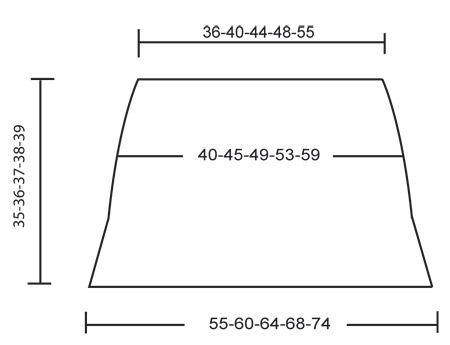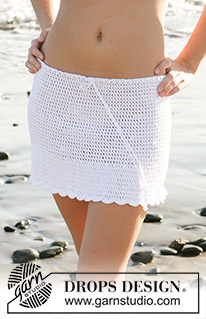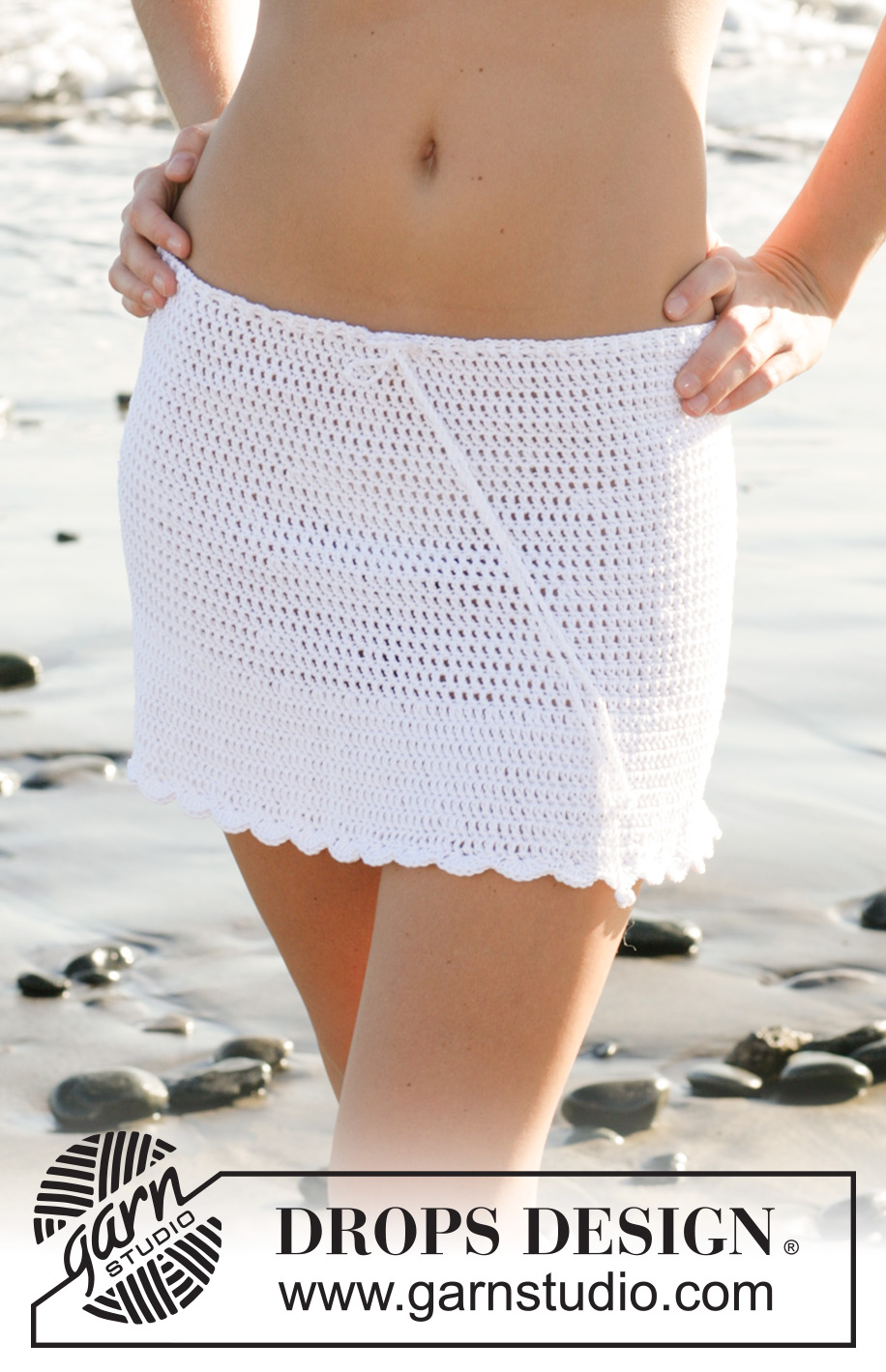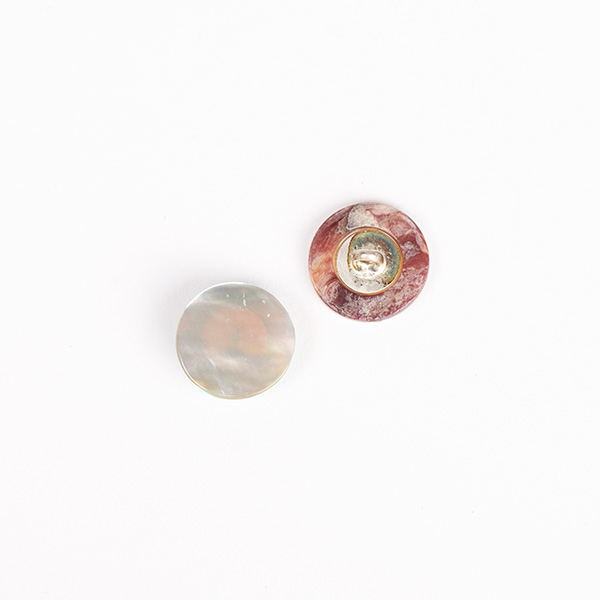Comments / Questions (55)
![]() Hello wrote:
Hello wrote:
Vilka maskor ska man virka i?
21.11.2024 - 08:41
![]() Andrea Kieslich wrote:
Andrea Kieslich wrote:
In der Beschreibung beim Rücken des Bikini steht, in der 5.LM beginnen. Soll das LM Bogen heißen ? Liebe Grüße Andrea
08.07.2024 - 18:17DROPS Design answered:
Liebe Andrea, ja, es ist richtig, es muss Lm-Bogen heißen. Die Anleitung wurde korrigiert und auch stellenweise sprachlich verbessert. Viel Spaß beim Weiterhäkeln!
12.07.2024 - 10:57
![]() NUNZIA RUBERTO wrote:
NUNZIA RUBERTO wrote:
Salve \r\nSto seguendo lo schema della gonna ma la larghezza del bordo superiore è stretta e non si riesce ad infilare dal basso. Per farla infilare anche la larghezza della vita deve essere come quella dei fianchi. Ho sbagliato qualcosa?
29.04.2024 - 21:56DROPS Design answered:
Buonasera Nunzia, trova lo schema delle misure in fondo alla pagina. Buon lavoro!
01.05.2024 - 21:37
![]() Michelle Hunt wrote:
Michelle Hunt wrote:
Hi, I am crocheting your DROPS crochet bikini top and skirt in “Muskat”pattern. I am unfamiliar with the binding off process. Is there a video to demonstrate this process, if not can you make one? Is the binding off tips the same as the crochet info in this pattern?
20.02.2024 - 06:19DROPS Design answered:
Dear Mrs Hunt, in This video we show how to decrease double crochet (US-crochet terminology) at the beginning and at the end of a row. Happy crocheting!
20.02.2024 - 08:46
![]() Valeria wrote:
Valeria wrote:
Salve sto facendo la gonna ed ho fatto il laccetto, ma rispettando le misure indicate viene molto più corto di quello della foto, sidovrebbe partire da 4 metri invece che da 3. Poi dalla foto si vede che la parte più bassa della gonna è fatta con un punto più fitto rispetto al resto, mentre nelle istruzioni è indicata tutta uguale. Che punto è? Grazie mille. Saluti.
18.02.2024 - 22:23DROPS Design answered:
Buonasera Valeria, se preferisce può partire da 4 m per fare il cordino. Non ci sono correzioni per la parte inferiore della gonna. Buon lavoro!
25.02.2024 - 16:21
![]() Isabelle Desert wrote:
Isabelle Desert wrote:
Bonjour je suis entrain de faire le bonnet et je ne comprends pas le rang 4 . doit on faire 3 ml ensuite maille suivante une bride et maille suivante une ms ? merci pour votre aide.
10.06.2023 - 11:07DROPS Design answered:
Bonjour Mme Desert, commencez le tour par 1 maille en l'air plutôt car c'est un tour de mailles serrées et répétez ainsi* 4 ml, sautez 1 bride, 1 maille serrée dans la bride suivante*. Bon crochet!
12.06.2023 - 09:39
![]() Mary Manoly wrote:
Mary Manoly wrote:
Hii its lovely i need to know in first increase of skirt the 15 stiches is devided over 3 rounds or all in one round .same as the 48 stiches for 2nd increase its all in one round?regards
17.05.2022 - 05:31DROPS Design answered:
Dear Mrs Manoly, when piece measures 10 cm, you increase 5 sts evenly, when piece measures 15 cm, you increase 5 sts evenly, when piece measures 20 cm, you increase 5 sts evenly. When piece measures 25-29 sts (see size), you increase 48 sts evenly. Read how to increase evenly on a round here. Happy crocheting!
17.05.2022 - 09:15
![]() Mary Manoly wrote:
Mary Manoly wrote:
Bonjours je vois que vous aver rajouter au jupe une augmentation do 3×5 c.est effectuee sur 3 ligne ou une seule? et le 48 m deusieme augmentation dans la même ligne? ou divise merci bien c.est adorable
17.05.2022 - 05:28DROPS Design answered:
Bonjour Mme Manoly et merci, si la réponse précédente n'a pas pu vous aider, n'hésitez pas à nous en informer. Bon crochet!
17.05.2022 - 09:16
![]() Carin wrote:
Carin wrote:
Sorry to be a pain so do you do a decrease double on the first and last stitches of strap row to decrease and then keep crocheting 4 across till strap length is right?
11.05.2022 - 16:07DROPS Design answered:
Dear Carin, decrease as explained at the beg of the pattern, ie under Binding off tip: crochet 2 slip sts at the beg of the row to decrease 2 dc, then stop the row when 2 sts remain at the end of the row, turn and work next row. Happy crocheting!
11.05.2022 - 16:09
![]() Carin wrote:
Carin wrote:
I don't understand the cup strap for shoulder/neck strap. The part I don't understand is the binding off on the beginning of strap and then how to make the strap as shown. Is it possible to get a couple minute video on that section. Thanks
11.05.2022 - 13:51DROPS Design answered:
Dear Carin, first work the strap (row 1 = 12 sts, row 2 = 8 sts, row 3 = 4 sts) to the required length, then work the Crochet border (see some lines down in the pattern) along all edges, including straps (= * 1 sc, skip 2 cm [3/4’’], 6 dc in the same dc, skip 2 cm [3/4’’]*, repeat from *-*.). Happy crocheting!
11.05.2022 - 15:54
Summer Sweetheart#summersweetheartbikini |
|
 |
 |
DROPS crochet bikini top and skirt in “Muskat” .
DROPS 99-28 |
|
|
Crochet tension: 16 tr x 10 rows = 10 x 10 cm. Crochet info: Replace the first tr on each round with 3 ch. Replace first dc on round with 1 ch. Finish each round with 1 sl st in first tr/dc/ch. Casting off tip (apply to bikini top): Cast off as follows at beg of row: crochet sl sts on the number of tr to be cast off. Cast off as follows at the end of row: Turn piece when number of tr to be cast off are left on row. Increasing tip (apply to skirt): Inc by crocheting 2 tr in 1 tr. Bikini top: Right cup: A-cup: crochet round 1 to 10, B cup: crochet round 1-12, C cup crochet round 1-14. Right cup: Crochet 4 ch with crochet hook size 4 mm and form a ring with a sl st. Continue as follows: Round 1: 5 dc in ring Round 2: 2 tr in each dc = 10 tr Round 3: 2 tr in each tr = 20 tr Round 4: *4 ch, skip 1 tr, 1 dc in next tr*, repeat from *-*, = 10 ch-loops Round 5: 4 tr in each ch-loop = 40 tr Round 6: *3 ch, skip 1 tr, 1 dc in next tr*, repeat from *-*, = 20 ch-loops Round 7: 3 tr in each of the first 2 ch-loops, *2 tr in next ch-loop, 3 tr in each of the next 2 ch-loops*, repeat from *-*, = 54 tr Round 8: *3 ch, skip 2 tr, 1 dc in next tr, 3 ch, skip 2 tr, 1 dc in next tr, 3 ch, skip 1 tr, 1 dc in next tr*, repeat from *-* and finish round with 3 ch, skip 2 tr, 1 dc in next tr, 3 ch, skip 2 tr and 1 sl st = 20 ch-loops Round 9: 3 tr in first ch-loop, *4 tr in next ch-loop, 3 tr in next ch-loop*, repeat from *-* and finish round with 4 tr in the last ch-loop = 70 tr Round 10: *3 ch, skip 2 tr, 1 dc in next tr, 3 ch, skip 3 tr, 1 dc in next tr*, repeat from *-* = 20 ch-loops (Cup size A finishes here) Round 11: 4 tr in each ch-loop = 80 tr Round 12: 4 ch, skip 3 tr, 1 dc in next tr*, repeat from *-* = 20 ch-loops (Cup size B finishes here) Round 13: Like round 11 = 80 tr Round 14: Like round 12 = 20 ch-loops (Cup size C finishes here) Now crochet shoulder/neck strap. Continue from last round on cup and crochet back and forth. Row 1: 3 tr in first ch-loop, 1 tr in first dc, *3 tr in next ch-loop, 1 tr in next dc*, repeat from *-* a total of 2 times = 12 tr. Turn piece. Row 2: 1 tr in each tr, but cast off 2 tr each side – see Casting off tip = 8 tr. Turn piece Row 3: 1 tr in each tr, but cast off 2 tr each side = 4 tr. Turn piece Row 4: 1 tr in each tr, and continue until strap measures approx 28 cm, or required length. Cut the thread and sew. Now crochet back strap as follows: Crochet as follows in the 5th ch-loop to the left of shoulder/neck strap: Row 1: 4 tr, 1 tr in next dc and 4 tr in next ch-loop = 9 tr Row 2: 1 tr in each tr, but cast off 2 tr each side – see Casting off tip = 5 tr. Turn piece Row 3: 1 tr in each tr, but cast off 1 tr each side = 3 tr. Turn piece Row 4: 1 tr in each tr, and continue until strap measures approx 30 cm, or required length. Cut the thread and sew. Left cup: Like right cup, but crochet back strap in the 5th ch-loop to the right of shoulder/neck strap. Now crochet the 2 cups tog as follows: beg at right cup. Crochet 4 tr in the 4th ch-loop from shoulder strap on the opposite side of back strap. Crochet 5 rows with 1 tr in each tr. Sew this piece to left cup. Crochet border: Crochet round all edges, incl straps and piece between cups, as follows: * 1 dc, skip 2 cm, 6 tr in the same tr, skip 2 cm*, repeat from *-*. Buttons: Sew on 1 button on shoulder/neck strap and 1 button on back strap. Use crochet border as buttonholes. Skirt: Crochet in the round from top down. Read Crochet Info! Crochet 151-171-187-203-231 ch on crochet hook size 4 mm and form a ring with a sl st. Crochet 1 tr in each of the first 3 ch, *skip 1 ch, 1 tr in each of the next 3 ch*, repeat from *-* and finish with 1 sl st in first tr from beg of round = 114-129-141-153-174 tr. Continue with 1 tr in each tr. When piece measures 10, 15 and 20 cm inc 5 tr evenly on round – see Increasing tip = 129-144-156-168-189 tr. When piece measures 25-26-27-28-29 cm inc 48 tr evenly = 177-192-204-216-237 tr. When piece measures 35-36-37-38-39 cn crochet a border along the bottom edge as follows: *1 dc, skip 2 cm, 6 tr in the same tr, skip 2 cm*, repeat from *-*. Cut the thread and sew. Ribbon: Cut 2 threads measuring approx 300 cm each. Twist until they resist and fold them double. Tie a knot either end and pull ribbon through the second row at top of skirt, beg mid front. |
|

|
|
Have you finished this pattern?Tag your pictures with #dropspattern #summersweetheartbikini or submit them to the #dropsfan gallery. Do you need help with this pattern?You'll find 11 tutorial videos, a Comments/Questions area and more by visiting the pattern on garnstudio.com. © 1982-2025 DROPS Design A/S. We reserve all rights. This document, including all its sub-sections, has copyrights. Read more about what you can do with our patterns at the bottom of each pattern on our site. |
|












































Post a comment to pattern DROPS 99-28
We would love to hear what you have to say about this pattern!
If you want to leave a question, please make sure you select the correct category in the form below, to speed up the answering process. Required fields are marked *.